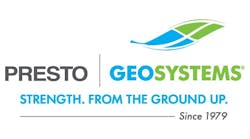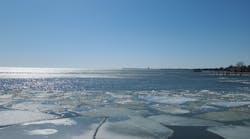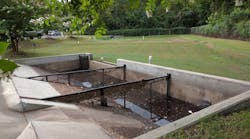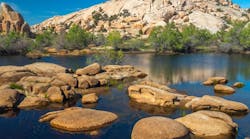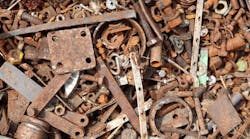Bill Handlos, P.E. is director for Presto Geosystems. Handlos can be reached at [email protected]. Sam Justice, P.E. is a civil design engineer at Presto Geosystems. She can be reached at sam. [email protected].
undefinedEconomic pressures, public desire for aesthetic green solutions and the increasing trend towards climate extremes are all factors in the growing need for effective soil-stabilization measures. In urban and rural environments, structures such as dams, landfill covers, lagoons and storm water containment basins need soil-stabilization systems to cover and protect geomembrane liners that are integral to the system. Soil, aggregate and concrete protective covers can be secured against known gravitational, hydrodynamic and seismic forces using 3D soil confinement systems, which are referred to as geocells.
Without the use of 3D geocell technology, soil and aggregate are commonly used over geomembranes on slopes of less than 3H:1V. When slope gradients are greater than 3H:1V, soil and aggregate covers need to be stabilized with a geocell system to avoid soil movement and potential failure. In arid areas, cover depth may range from 3 to 6 in. In conditions that support vegetation and cover, depth may range from 6 to 24 in. or greater where the final depth is a function of the vegetation’s characteristics. Geocells are available in depths from 3 to 8 in., allowing for sufficient coverage to protect the geomembrane from UV degradation, punctures, water seepage and water infiltration.
Regardless of cover depth, if an extreme rainfall event occurs that is 10%, 20% or 30% greater than expected, the soil mass increases, assumed friction angles decrease, and the factors of safety for soil stability drop to a point where failure of the cover occurs and exposure of, or damage, to the geomembrane results.
Geocell technology prevents the cover material from sliding, even under heavy rain or snow loads, and reduces the amount of lifetime maintenance required to protect the geomembrane liner.
Geomembrane Protection
Landfills are a common structure requiring a geomembrane. A residue disposal area at a pulp paper mill in Bahia, Brazil, suffered a failure of the existing unconfined soil cover due to heavy rains. The area was repaired with the Presto Geoweb 3D soil stabilization system. The 3D structure confines fill material in its network of interconnected cells, keeping the fill stable and resistant to movement.
For many years, the mill dumped eucalyptus tree trunks and bark, lime, contaminated soils and other waste on
the site creating a large pile of environmentally damaging materials. Pressure from regulatory agencies, as well as obvious environmental issues, motivated the mill to take action.
The remediation objectives were to:
- Prevent rain and wind dispersion of residues and contaminants;
- Prevent infiltration of contaminants into the aquifer;
- Prevent contaminated residues from coming in contact with personnel and animals; and
- Develop an aesthetically pleasing landscape.
A solution then was developed considering the four objectives and the future need to use the dumpsite for additional waste.
Original Remediation
The remediation work started with the re-grading of the residue to a stable slope of 3H:1V. This grade also guaranteed the stability of the residue and allowed for the placement of additional waste on top of the existing residue.
After the earthwork was completed a few months later, confinement work began. First, a gas collection system was installed. Next, a 1.5 mm (60 mil) thick, textured, high-density polyethylene (HDPE) geomembrane was installed. A 6 oz/sq yd non-woven geotextile was installed over the geomembrane as a protection layer and subsequently covered with 24 in. of soil. Within the soil cover, a subsurface drainage system was installed to assist with removing infiltrating rainwater. The drainage system used 4-in. diameter perforated PVC pipe installed directly over the geotextile 33 ft on center, allowing the groundwater to pass through the pipe collection system and discharge into a surface channel at the toe of the slope.
Failure of the Soil Cover
In this region of Brazil, the rainy season starts in April and lasts through September. Due to climate change, heavy rains may also occur in other months. Only six months later after a heavy rainfall, the soil cover on the 3H:1V slope failed at the geotextile-geomembrane interface, and a large volume of soil slid down the slope from crest to toe. Furthermore, at some locations along the slope crest, the geotextile tore due to the sliding soil, exposing the geomembrane.
Factors in the failure included a relatively low interface friction angle between the geotextile and the textured geomembrane, increased load from the saturated soil and seepage forces due to water flow within the relatively thick soil cover layer. The failure involved 12,900 cu ft of cover soil and 19,400 cu ft of geotextile. Although the geomembrane was not yet affected by the tear in the geotextile, an urgent repair was needed to prevent damage.
3D Geocellular System Cover Repair
After a complete analysis of the failure, several alternatives were considered for the repair. However, use of the Geoweb slope cover system best addressed all critical details. The following parameters were considered critical for the redesign of the soil cover system:
- Slope heights from 66 ft to 115 ft;
- 3H:1V (18.4°) slope angle;
- Critical interface friction angle between the sand and geomembrane of 15°;
- Total slope soil-cover of 24 in;
- Cover anchoring system to resist all potential loading;
- Self-sustainable vegetated cover; and
- A need for a drainage system that would quickly drain extremely saturated soil, and (8) long-term functional life.
The new cover consisted of two layers to make up the 24 in. cover, a 3-in. sand-infilled, perforated Geoweb drainage layer installed directly over the textured HDPE geomembrane, topped with 21 in. of soil. In areas where the original geotextile had not failed, the Geoweb sections were installed directly over that geotextile layer. The use of a sand drainage layer provided two benefits:
- Increased friction angle at the critical interface with the geomembrane; and
- Provision of a critical system drainage layer. In some areas, due to the characteristics of the final 21 in. depth topsoil layer, a 6 oz per cu yd non-woven geotextile filter and separation layer was placed over the sand-infilled Geoweb layer. In other areas, this geotextile layer was not used because the final soil cover had characteristics compatible to the sand drainage layer.
The Geoweb sections were structurally anchored at the slope crest using high-strength polyester tendons with a long-term design strength of 3,000 lbf. The required strength considered the fully covered and saturated soil mass over and in the Geoweb sections. For the 115-ft-long slopes, the analyses determined five polyester tendons per Geoweb section were required. Tendons were secured to a 4-in. diameter, solid wall, PVC pipe deadman buried 18 in. below the final grade at the crest of the slope. The tendon strength design factor-of-safety was 5.0, and it included partial factors of safety for creep, knots, constructions damage, chemical and biological durability and overall uncertainties. All present and potential sliding forces within the Geoweb system were transferred to the tendons by means of special load transfer ATRA clips at required downslope intervals. Proper design analyses to determine tendon and load transfer requirements, as well as geocell seam strength are precritical factors to the overall long-term performance of the cover system.
During construction, the tendoned and perforated Geoweb material provided a stabilizing “formwork” that prevented sand flow during installation during rainfall, as well as allowing for rapid drainage of the saturated sand infill. The tendoned Geoweb system is a unique way to create a structurally stable sand drainage layer directly over a geomembrane.
Results of the Cover Repair
Construction work took place over a three-month period. The system has performed exceptionally well through multiple rainy seasons. Technological advancements provide improved methodologies and materials so sustainable, long-term solutions can be developed for some of the most challenging site situations. The Geoweb system proved to be a technically sound, low environmental impact solution with high cost-benefit for this project.

